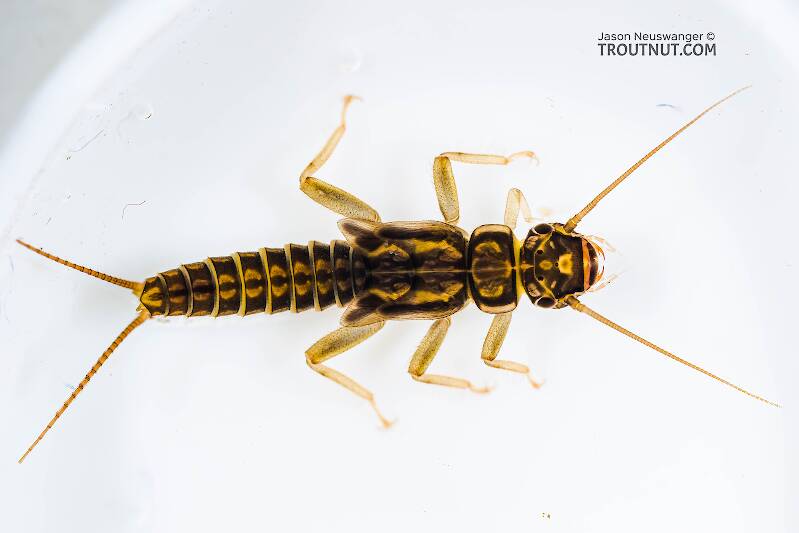
Hex Mayflies
Hexagenia limbata
The famous nocturnal Hex hatch of the Midwest (and a few other lucky locations) stirs to the surface mythically large brown trout that only touch streamers for the rest of the year.


Mayfly Species Anthopotamus myops (Golden Drakes)
Where & when
Many authors report that this is the most important species of Anthopotamus in the Midwest. I have found very little about the habits of this species except for a paragraph in Hatches II about Anthopotamus rufous, a synonym of myops:Although our experience with this species is limited this mayfly seems to have great trout appeal. Ernie Schwiebert reports excellent fishing hatches of rufous taking place on our larger Eastern and Midwestern rivers that remain cool throughout the summer.
Caucci and Nastasi go on to list some Eastern rivers where this species is important. It is noteworthy that this species, or at least the synonym being discussed, is not as tolerant of warm water as others of the genus. I don't know if this holds true for the original myops populations which are said to be important in the Midwest.
In 53 records from GBIF, adults of this species have mostly been collected during June (45%), July (34%), and August (17%).
In 33 records from GBIF, this species has been collected at elevations ranging from 679 to 5003 ft, with an average (median) of 3133 ft.
Species Range
Physical description
Most physical descriptions on Troutnut are direct or slightly edited quotes from the original scientific sources describing or updating the species, although there may be errors in copying them to this website. Such descriptions aren't always definitive, because species often turn out to be more variable than the original describers observed. In some cases, only a single specimen was described! However, they are useful starting points.
Male Spinner
Wing length: 11.5 mm
Head fuscous, remainder of body pale; tail joinings faintly darker; wings wholly pale.
Head fuscous to purplish brown. Eyes of male small. Thorax pale yellowish; median reddish streak on pronotum, also on anterior portion of mesonotum of one specimen. Legs yellowish white. For tibia infuscated at tip, also tarsal joinings. All joints of fore tarsus faintly smoky. Fore femur with faint reddish tinge. Wings hyaline, whitish, “with pinkish iridescence” (Needham); all veins wholly pale. Abdomen translucent, yellowish white; apical tergites “of a dull satiny whiteness” (Ndm.). Very faint opaque brownish areas on each tergite in same position as distinct dark Iateral spots on some species of this genus. Tails white, joinings very faintly darker.
Described as P. myops
Body length 12-13 mm Wing length 12.5-13 mm
Eyes of male small; wings wholly pale, in both sexes; abdominal segments 1-5 ferruginous, but no lateral markings.
Walsh's description is largely a comparison with P. flaveola (now a synonym of Anthropotamus verticis), in which he states the size of male (did not have female); eyes “separated by a space 2.5 times their own diameter”; no lateral fuscous markings on abdomen, but one of his two specimens had abdominal segments 1-5 ferruginous, “6 and 9 paler, 7 and 8 yellowish”; the entire abdomen of the other specimen was yellowish. Dr. McDunnough states that the wings of the female have no black cross veins; the comparison with flaveola(now a synonym of Anthropotamus verticis), by Walsh, would indicate wholly pale wings in male also. One would expect, further, that the vertex would be ferruginous; thorax pale ferruginous; legs yellowish, apical portion of fore femur reddish, tips of tibia and tarsal joinings fuscous; abdomen yellowish; tails whitish, joinings fuscous.
Described as P. rufus
Body length 15 mm Wing length 13.5-14 mm
Vertex and thorax reddish; fuscous spots on sides of abdominal tergites; tail joinings reddish; wings wholly pale, in both sexes.
Eyes of male small, separated by a space equal to 2.5 diameters of eye; eyes of female small, separated by at least three eye diameters. Vertex of head, and antennae, reddish; thorax likewise ferruginous. Fore femur and tibia “strongly ferruginous” at tips; tarsal joinings fuscous. Wings wholly pale, without darker cross veins, in both sexes. Abdomen yellowish, with “fuscous spots on sides of segments.” Tails with joinings “strongly ferruginous” in both sexes. Fore femur and tibia of female reddish throughout their lengths. Female said to be “more strongly ferruginous” than male.
Female Spinner
Wing length: 10.5-11.5 mm
Vertex and prothorax with broad median stripe; tails joinings brownish; only female is known. Head and thorax pale yellowish; a “broad median reddish stripe on prothorax and vertex of head, and less distinctly on mesothorax; the part on head is broader then elsewhere, and on the face it is broadened to reach the eyes, or nearly so” (Banks). Eyes of female “scarcely if any more than two diameters apart.” Fore femur and tibia slightly infuscated at apex. Tails narrowly brownish at joinings; median tail “rather smaller than the others.”
Start a Discussion of Anthopotamus myops
References
- Arbona, Fred Jr. 1989. Mayflies, the Angler, and the Trout. Nick Lyons Books.
- Caucci, Al and Nastasi, Bob. 2004. Hatches II. The Lyons Press.
- Knopp, Malcolm and Robert Cormier. 1997. Mayflies: An Angler's Study of Trout Water Ephemeroptera . The Lyons Press.
- Needham, James G., Jay R. Traver, and Yin-Chi Hsu. 1935. The Biology of Mayflies. Comstock Publishing Company, Inc.
Mayfly Species Anthopotamus myops (Golden Drakes)
Species Range
Common Name
Resources
- NatureServe
- Integrated Taxonomic Information System
- Global Biodiversity Information Facility
- Described by Walsh (1863)

